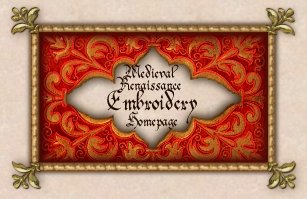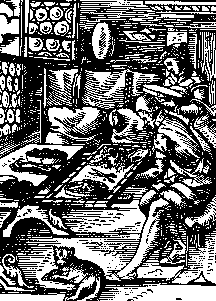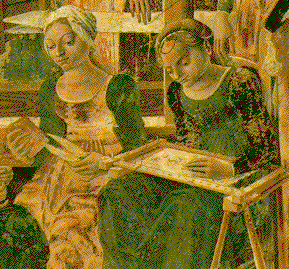
Medieval/Renaissance Embroidery Homepage
Top Level Page
I, Hildegarde, humbly request that you do not assume me to be an expert on
this topic. I have webbed this page merely to make available material on the topic of
Embroidery in the Medieval and Renaissance period. There are also some links
to modern embroidery pages. If it doesn't appear within these pages, I probably don't know the answer... this is more a work of collecting other people's knowledge than of disseminating my own.
I put this together in the early days of the World Wide Web, starting with some designs by Master Richard Wymarc that were otherwise only available on Compuserve. I wrote to him for permission to web those designs, and he gave it. To this, inspired by Stefan's Florilegium (which isn't what it was called in those days), I sorted and collected some messages from discussions on various mailing lists that I thought should be preserved for their helpfulness. The copyrights belong to those authors. Today, this site is rather quaint, but in its defense, it was the only site on this topic available for quite some time.
It has been quite a while since I've actively maintained this set of pages, other than to periodically check for broken links. However, since this site HAS been on the web so long, it generally shows up at the top of the list of sites returned by search engines when someone searches for "Medieval Embroidery". I would recommend going to Master Richard Wymarc's site, or to Clare's Medieval and Renaisssance Embroidery Page for a more actively updated site on this topic.
I've been known to be lousy at responding to email in a timely fashion, and I'm actually not the most knowledgeable person on this topic around, so if you have a question about historical needlework, I highly recommend posing it to the experts on the H-Needlework mailing list.



The Bayeux Tapestry Site
Bayeux Tapestry portion of The Battle of Hastings 1066 Site
Dr. Martin Kennedy Foys Shockwave version of the Tapestry
Ibis Communications' Invasion Of England, 1066 site (illustrated with the tapestry)
This piece, measuring 221 feet long and between 18 and 21 inches wide is, of course, actually not a woven tapestry, but an embroidery. It was done in colored wools on a linen ground. The stitching is laid and couched work in the solid shapes, with details in stem stitch. This piece was done between 1066 and 1082, and was probably commissioned by Bishop Odo of Bayeux.
For a long time, this page had a link to a page put up by Gwydion ap Myrddin (Matt Stum), but this link now appears to be dead (http://blah.bsuvc.bsu.edu/bt).
Bayeux Couching
Rialto Bayeux Tapestry Threads
Rialto Tapestries Threads
Christus Rex Site
"CHRISTUS REX is a a private, non-profit organization dedicated to the dissemination of information on works of art preserved in churches, cathedrals and monasteries all over the world. We intend to assemble a collection of images that will constitute a visual representation of the Bible, ad maiorem gloriam Dei! (for the greater glory of God!)" This site currently contains jpegs of art in the Vatican City, Sistine Chapel, Raphael Stanze, Loggia, and the Vatican Museums. The following links are some of what you can find there:
Stefan's Florilegium - Threads from the Rialto
Articles in Needlework Periodicals, Catalog Sources
- Assisi Embroidery
- Sometimes known as voiding, this technique involves long-armed cross stitch and double-running stitch (Holbein stitch). The motif is outlined in the running stitch, while the background is colored in with cross-stitch. The motif itself is left "void". The first examples from Assisi, Italy date as far back as the 13th century. I've found an article in the British needlework magazine "Mary Hickmott's New Stitches" Issue 9, p. 54+ "Assisi Embroidery". This same issue also contains a blackwork portrait of Jane Seymour. (ISSN 0967-5884)
- Double-Running Stitch (Blackwork, Holbein Stitch)
- An article in the February 1994 issue of Just Cross Stitch, "Beyond the Basics: Double-Running Stitch" by Lorna Reeves (p. 50+), shows stitch by stitch how to create a grape pattern for a bookmark. (ISSN 0883-0797)
- Design Sources Recommended Threads
- Buying or Making Garb (aka costume)

Links to Parts Elsewhere


 Hildegarde Stickerin, Barony of Wurm Wald, Midrealm
Hildegarde Stickerin, Barony of Wurm Wald, Midrealm
Copyright © 1994-1999 Joan Schraith Cole.
Updated May 27, 2000 (links checked)
The most current address to this page is
http://www.advancenet.net/~jscole/medembro.html











